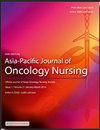乳腺癌患者睡眠与癌症相关疲劳之间的相互作用:一项随机的计算机模拟网络分析
IF 2.8
3区 医学
Q1 NURSING
引用次数: 0
摘要
睡眠问题和癌症相关的疲劳是乳腺癌患者在治疗期间和治疗后的常见症状。确定该症状群的关键干预目标可以改善患者报告的结果。本研究旨在探讨睡眠与癌症相关疲劳之间的关系,以确定最佳干预目标。方法在“抗乳腺癌”项目中,采用多维疲劳症状短表和匹兹堡睡眠质量指数收集睡眠和癌症相关疲劳的自我报告数据。采用高斯网络分析来识别中心症状和节点,而贝叶斯网络则探索它们的因果关系。使用计算机模拟干预来确定核心症状作为干预目标。结果一般疲劳(Str = 0.95, Bet = 7, Clo = 0.007)被认为是中心性最强的节点。匹兹堡睡眠质量指数的日间功能障碍项桥强度最强。通过计算机模拟分析确定核心症状为干预目标。结论:从休闲社交的角度来看,睡眠质量是癌症相关疲劳的最强预测因子。睡眠潜伏期和白天功能障碍应该有针对性地打破睡眠和癌症相关疲劳之间的连锁症状相互作用。本文章由计算机程序翻译,如有差异,请以英文原文为准。
The interplay between sleep and cancer-related fatigue in breast cancer: A casual and computer-simulated network analysis
Objective
Sleep problems and cancer-related fatigue are common symptoms in women for breast cancer, during and after treatment. Identifying key intervention targets for this symptom cluster may improve patient reported outcomes. This study aimed to explore the relationship between sleep and cancer-related fatigue to identify optimal intervention targets.
Methods
In the “Be Resilient to Breast Cancer” program, self report data were collected on sleep and cancer-related fatigue the Multidimensional Fatigue Symptom Inventory–Short Form and the Pittsburgh Sleep Quality Index. Gaussian network analysis was employed to identify central symptoms and nodes, while a Bayesian network explored their causal relationships. Computer-simulated interventions were used to identify core symptoms as targets for intervention.
Results
General fatigue (Str = 0.95, Bet = 7, Clo = 0.007) was considered the node with the strongest centrality. The daytime dysfunction item on the Pittsburgh sleep quality index had the strongest bridge strength. Core symptoms were identified as targets for intervention by the computer-simulated analysis.
Conclusions
Sleep quality is the strongest predictor of cancer-related fatigue from a casual networking perspective. Sleep latency and daytime dysfunction should be targeted to break the chained symptom interaction between sleep and cancer-related fatigue.
求助全文
通过发布文献求助,成功后即可免费获取论文全文。
去求助
来源期刊

Asia-Pacific Journal of Oncology Nursing
Multiple-
CiteScore
2.80
自引率
11.10%
发文量
136
审稿时长
31 days
 求助内容:
求助内容: 应助结果提醒方式:
应助结果提醒方式:


